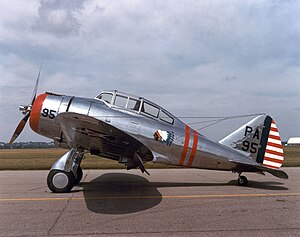Seversky P-35
| P-35 | |
|---|---|
 |
|
| P-35 (36-404) marked as P-35A in the USAAC at the National Museum of the USAF | |
| Role | Fighter |
| Manufacturer | Seversky |
| First flight | 15 August 1935 |
| Introduction | 1937 |
| Retired | September 1952 (Sweden) |
| Primary users |
United States Army Air Corps Swedish Air Force |
| Number built | 196 (inc. export) |
| Unit cost |
US$22,500
|
| Variants |
P-43 Lancer Seversky SEV-3 |
The Seversky P-35 was a fighter aircraft built in the United States by the Seversky Aircraft Company in the late 1930s. A contemporary of the Hawker Hurricane and Messerschmitt Bf 109, the P-35 was the first single-seat fighter in U.S. Army Air Corps to feature all-metal construction, retractable landing gear and an enclosed cockpit.
The origins of the P-35 trace back to the Seversky SEV-3 three-seat amphibian, designed by Alexander Kartveli, Seversky's chief designer and Seversky's first aircraft. The SEV-3 first flew in June 1933 and was developed into the Seversky BT-8 basic trainer, 30 of which were ordered by the United States Army Air Corps (USAAC) in 1935. This proved grossly underpowered and was quickly replaced by the North American BT-9.
The second prototype SEV-3 was completed as a two-seat fighter derivative, the SEV-2XP. It was powered by a 735 hp (548 kW) Wright R-1820 radial engine, had fixed landing gear in aerodynamic spats and was armed with one .50 in (12.7 mm) and one .30 in (7.62 mm) forward-firing machine guns plus an additional .30 in (7.62 mm) gun for rear defence.
When the USAAC announced a competition for a new single-seat fighter in 1935, Seversky sent the SEV-2XP, confident it would win despite being a two-seater. However, the aircraft was damaged on 18 June 1935 during its transit to the fly-offs at Wright Field. To compete with the Curtiss Model 75, a single-seat aircraft with retractable undercarriage, Seversky rebuilt the aircraft into the single seat SEV-1XP, replacing the SEV-2XP's fixed landing gear with a retractable undercarriage where the mainwheels retracted backwards into the wing, and an 850 hp (634 kW) R-1820-G5 replacing the -F3 of the SEV-2XP. The SEV-1XP was delivered to Wright Field on 15 August for evaluation, which was generally successful, although the Cyclone failed to deliver its rated power and the SEV-1XP only reached 289 mph (465 km/h) rather that the 300 mph (483 km/h) predicted by Seversky.
...
Wikipedia
